AVOIDING MEMORIES
Counter-Trauma aftereffects
An art & science exhibition about strategies for dealing with the aftereffects of trauma at Meta Spatiu / mv-sci Art Timisoara
ARTIST
Guadalupe Aldrete * Mila Balzhieva * Paula Flores * Natalia Gurova * Hubert Hasler *
Gabriel Virgilio Luciani * Isidora Krstic * Mihai Zgondoiu
Curator Denise Parizek
Opening 7.11. 2024 MV-sci Art Timisoara
8.11. 2024 Guided Tours & Talk
Duration 8.11. – 7.12.2024
AVOIDING MEMORIES CATALOG 2024-Avoiding_CatalogNEW-WEB
Copie a fișierului Revista presei- Avoiding Memories
REVISTA ARTA Avoiding Memories by Miruna Robescu
Vermeidung ist eine der Hauptstrategien, um mit den Nachwirkungen eines Traumas umzugehen. Vermeiden von Erinnerungen. Vermeiden der nicht integrierten Fragmente der Vergangenheit, die immer wieder getriggert werden. Wie sollen wir mit dieser Bedrohung unserer psychischen Gesundheit umgehen, wie können wir in einer Zeit mit Kriegen, Hungersnöten, Klimakrise, Rechtsruck mit unseren persönlichen Geschichten fertig werden, wenn immer neue Probleme auf uns eintrommeln?
Wir versuchen gemeinsam, ausgehend von verschiedenen Ansätzen und persönlichen Erfahrungen, Methoden der Vermeidung auszuloten, wir hinterfragen, ob vermeiden die einzige Lösung ist und ob es andere, wissenschaftliche oder medizinische Hilfsmittel gibt, um die heutigen psychischen Problemen zu lösen.
Avoidance is one of the main strategies for dealing with the after-effects of trauma. Avoidance of memories. Avoiding the unintegrated fragments of the past that are triggered again and again. How should we deal with this threat to our mental health, how can we cope with our personal stories in a time of wars, famine, climate crisis, shift to the right, when new problems are constantly being drummed into us?
Based on different approaches and personal experiences, we will try to explore methods of avoidance together, we will question whether avoidance is the only solution and whether there are other scientific or medical tools to solve today’s mental health problems.
AVOIDING MEMORIES
Mariana Abramovic works out her trauma on her own body, she went into the pain again and again until she literally hit the ground. Artists may be able to overcome trauma in this way, but the wounds are still there. Avoidance is one of the main strategies for dealing with the after-effects of trauma. Avoidance of memories. Avoiding the unintegrated fragments
of the past that are triggered again and again. The debates about trauma, femicide, violence, climate crises, migration, wars, global political and social tensions are overwhelming. They trigger new triggers. Together we try to explore methods of avoidance based on different approaches and personal experiences, we question whether avoidance is the only solution, whether there are other scientific or medical tools to solve today‘s mental health problems.
In Monumental Cares (Manchester University Press 2023), Mechthild Widrich discusses artistic and activist interventions that show that a site- and personcentred engagement with history is important for a functioning, democratic public sphere and that we need to create new, participatory forms of art.
How can we reach a new level of discussion via art, in which the problems of today are presented and thematised in order to save us from fascist patriarchal backlashes and other global problems? In her ‘Story of a counter monument’, Patrizia Viola describes the idea of taking existing places / exhibitions out of context and reinterpreting and redesigning them through joint intervention. How can we give a living meaning to what reminds us of the trauma?
Denise Parizek Curator
PICTURES OF THE EXHIBITION

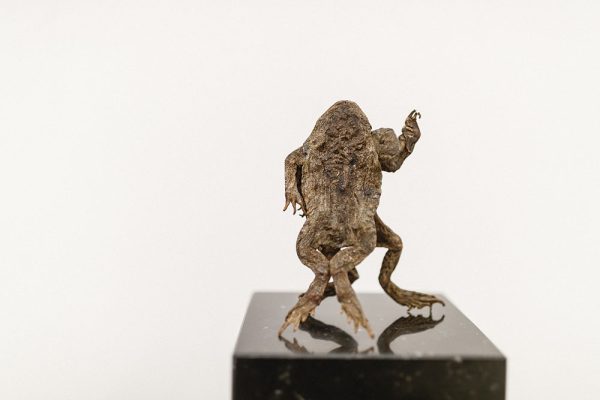

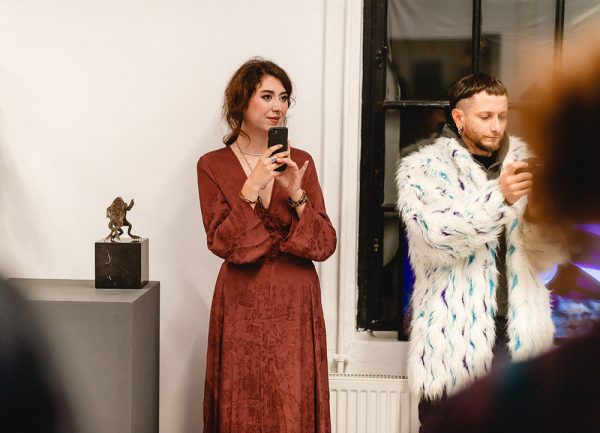




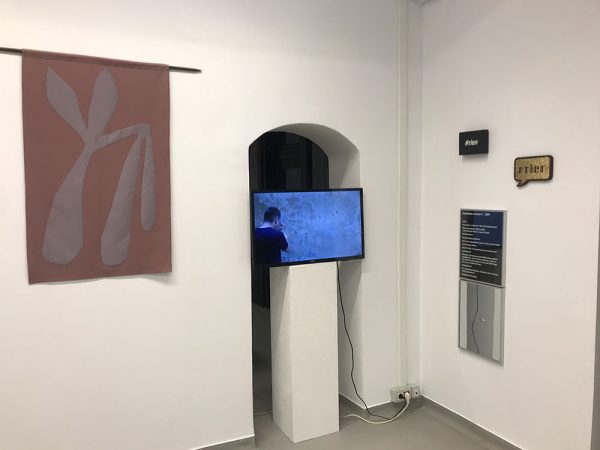
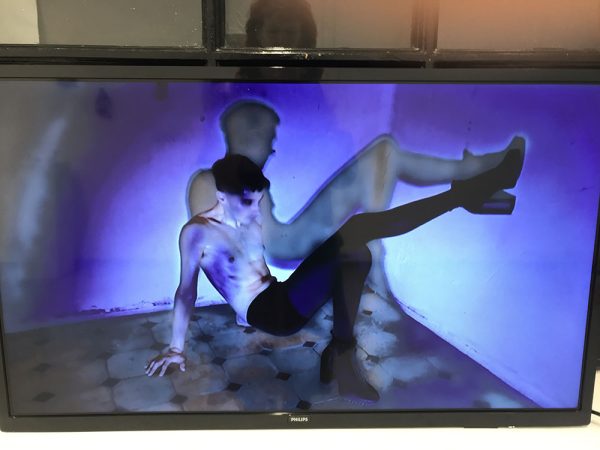
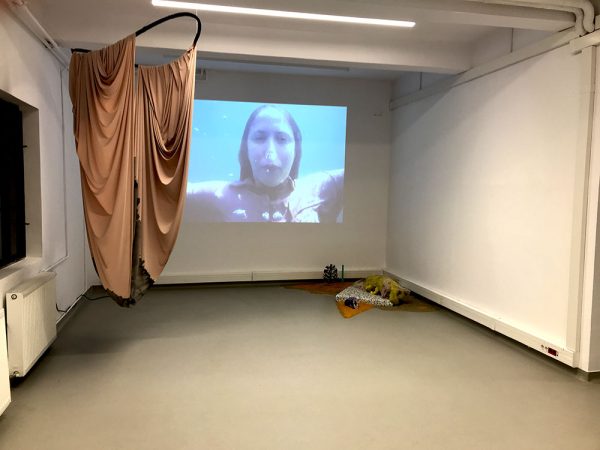
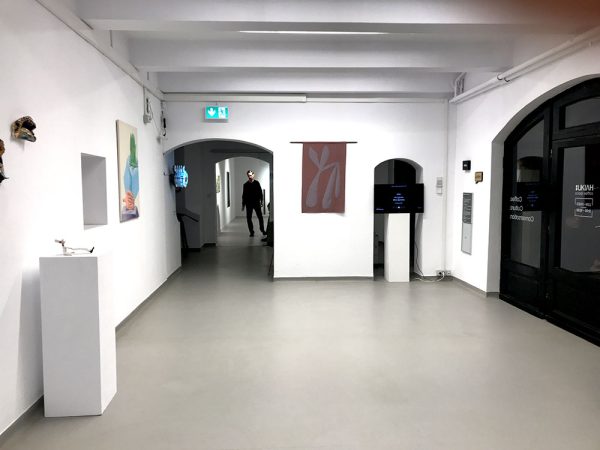
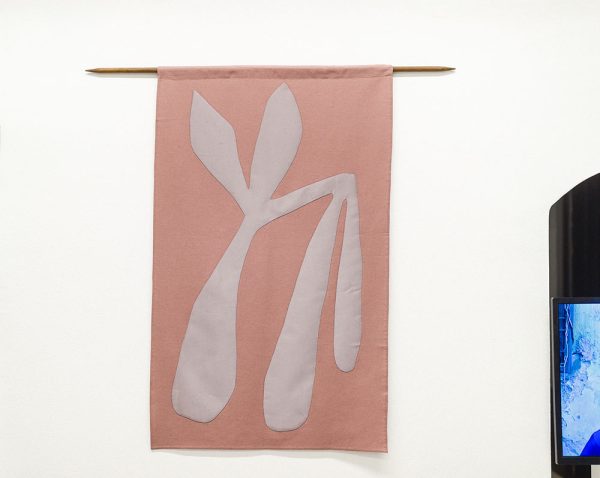
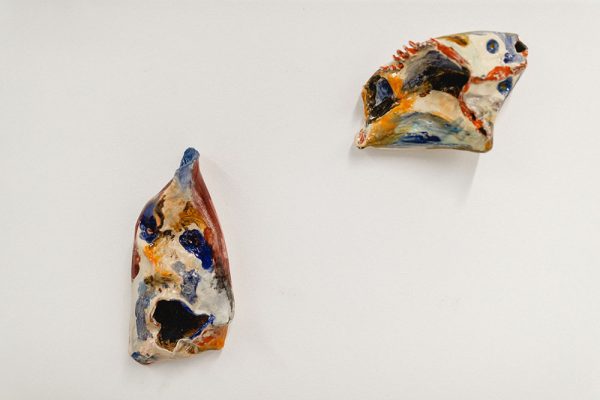



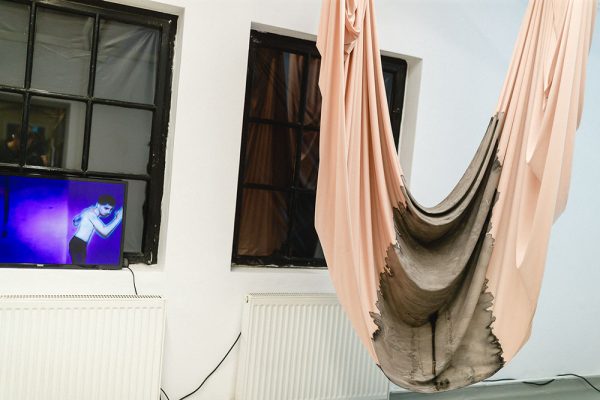

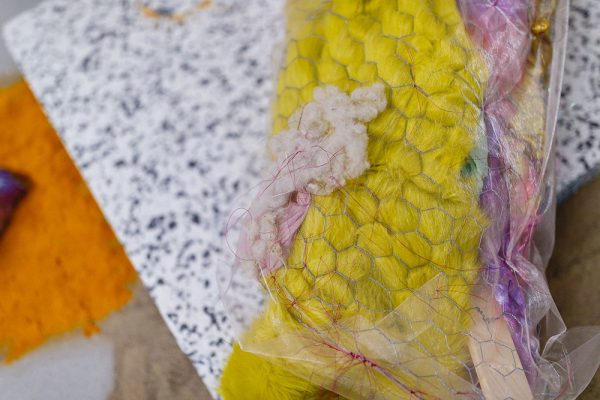

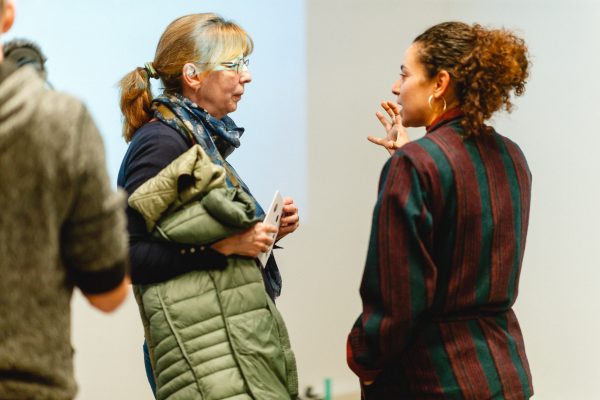
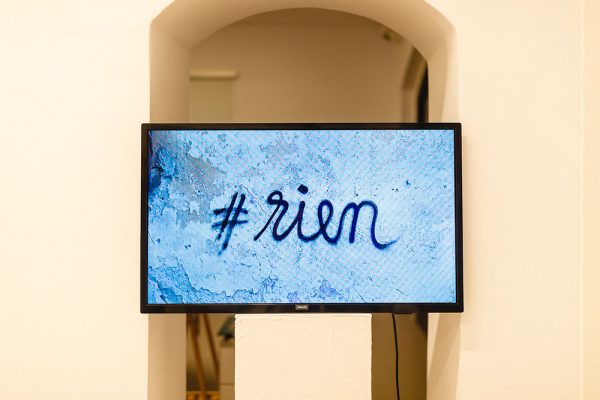


PHOTOCREDITS by Tudor Popa / Meta Spatiu 2024
Special thanks for joining us to: Ileana Pintilie, Mirela Vladuti and Dan, NOIMA, Ciprian Bodea. Sorin Scurtulescu, Cosmin Fruntes, Andrei Rosetti and their partners and children, Constantin Flondor, Gabriel Kohn, Renee Renard, Alex Mirutziu, the team of Meta Spatiu, Ioana, Miruna, Alex, Miriam, Rosemarie Barrientos and to all the visitors
ARTISTS / KÜNSTLER
Banderola III
Installation 2024
Fabric, Metall, Ink
Inspired by cave interiors, Banderola III reflects humanity’s first spaces of protection and connection. These were spaces where humans gathered as families, shared stories, and communicated their hopes, fears, and expectations. Caves were also sacred places, where ancient people paid tribute to their deities and explored their inner worlds by navigating the chambers of the earth. Caves symbolise for me the meeting point of my ancestors, who at some moment decided to migrate southwards but returned over generations to honour their shared bodily and cosmic roots. An example of this would be the caves of La Pintada in Mexico. The installation mimics natural cave formations like drapery and flowstones, echoing the slow, con- tinuous flow that shapes them. This mirrors the flow of ancestral memory through generations, still present in our somatic and epigenetic memory. Drawing on psychological/ anthropological/ archaeological research, such as David Lewis-Williams‘ work, who suggests a direct connection between journeys into caves and the retrospection that helped shape early human intellectual and spiritual development, the artwork’s colours symbolise the inner landscapes of each person and the intergenerational heritage passed down through family lines.
Guadalupe Aldrete, früher bekannt als Lala Nomada, ist eine mexikanische multidisziplinäre Künstlerin mit Sitz in Wien. Geboren wurde sie in Mexico, sie studierte in den USA und an der Universität für Angewandte Kunst, Art & Science, Wien.
Guadelupe Alerte versucht die Verkörperung von Erbe und Abstammung performativ darzustellen. Ikonografisch gesehen stellt die Farbe Rosa die Haut dar, aber die Haut im Inneren unseres Körpers, wo wir alle gleich aussehen, wo unsere Nerven verlaufen. Schwarz referiert auf die Arbeit meines Vaters in einer Ölraffinerie und beruft sich gleichzeitig auf die Materialisierung meiner Ahnen und deren Lasten, die sie geerbt haben.
NEUROPTERIS-2
Textile Cotton, Taffeta
2024
„Neuropteris-2“ is a part of a textile series that examines the interplay between handcraft and digital aesthetics, focusing on extinct flora. Each piece is hand-sewn, drawing inspiration from long-lost plant species, blending the real with the imagined. In Neuropteris-2, reinterpreted ancient forms merge, creating a new botanical vision that feels both familiar and otherworldly. The work reflects nature‘s resilience and transformation, openning a dialogue between the extinct and the speculative. This piece embodies the tension between the organic patience of handcraft and the sleek, abstract influences of digital design, bridging past, present, and imagined futures.
Mila Balzhieva ist eine interdisziplinäre Künstlerin/Designerin, geboren in der Republik Burjatien geboren und lebt derzeit in Wien, Österreich. Ihre Arbeit erforscht die Kommunikation zwischen Kommunikation, Schamanismus und symbiotische Beziehungen durch Bio- und digitalen Medien, Textilien, Videos und Zeichnungen, die sich mit Posthumanismus und botanischen Themen.
INVISION JAGUARS
Growing Sculpture 2024
fungi, chili and wax
Once again I call upon our tears to open the channels for life infusion. Permeating tears that activate lifes interconnectedness.
For that life giving energy that is not stopped by time or space. It is not with the intention to drain empty tears as cleansing eye water or to invite and praise empty sensitivity. LIFE itself can never be fully soft and easy for the one who lives it and for the lives attached to each other. LIFE can never be by human standards fairly and equally proportionate either in the good or the bad. Somehow we insist on control and predictability. LIFE needs freedom in its own definition.
Geboren in Mexiko, lebt seit 5 Jahren in Wien. Absolvierte das Studium von Art&Science. Stellt inter- national aus, in diversen Sammlungen von Museen vertreten. Ihre performativen Installationen beziehen sich einerseits auf ihre Wurzeln in Mexiko und der Kolonialgeschichte, andererseits bezieht sie sich auf Pflanzen und Tiere ihrer ursprünglichen Lebensumgebung und gibt ihnen eine Stimme.
Ähnlich wie Archie Moore im Australischen pavilion auf der Biennale involviert Flores die Horizontale Gentransfer Linie in ihre Projekte und stellt so das Gesamtprojekt Leben dar.
THE HOLLOW SHELL
Sculpture 2024
Glazed ceramics
The first ceramic figure of the series, with its elongated head and distorted body, symbolizes the effects of trauma and avoidance. The pale, hollow form suggests dissociation, while the deep red marks hint at unresolved wounds. The twisted, contorted posture represents the emotional tension of avoidance, with small black shoes grounding the figure in an unsettling reality.
Evoking feelings of fragmentation and alienation, the piece challenges viewers to question whether avoiding painful memories truly protects us or leaves us more disconnected from ourselves.
Natalia Gurova ist Journalistin und Künstlerin auf Zeit, wie sie es selbst bezeichnet. Sie wurde in Weißrussland geboren, wuchs im Norden Russlands auf, absolvierte eine Ausbildung zur Journalistin und arbeitete mehr als 10 Jahre lang im Bereich verschiedener Medien. Seit 2014 lebt sie in Wien und studierte ortsspezifische Kunst an der Universität für angewandte Kunst und studiert derzeit Bildhauerei an der Akademie der bildenden Künste. Ihre multidisziplinäre Praxis umfasst Skulptur, Druckgrafik, Zeichnung, ortsspezifische Installationen und kuratorische, diskursive Projekte. Bei ihrer Arbeit mit den sich überschneidenden Diskursen des spekulativen Geschichtenerzählens, räumlicher Experimente, postsowjetischer Kontexte, Zeitkonzepte und des Sammelns verweigert Gurova kategorische Unterscheidungen und operiert fließend zwischen Konzept und Handwerk. In ihrer Praxis verwebt sie unterschiedliche künstlerische Disziplinen sowie kulturelle und soziale Gemeinschaften – mit gemeinsamen Beziehungen zum Wesen von Objekten und ihrer Symbolik. Ihre Praxis dreht sich darum, Räume für bedeutungsvolle Begegnungen zu öffnen. Sie versteht diesen Fokus als eine strategische Wendung gegen den starren institutionellen Rahmen, der die transgressiven Potenziale des künstlerischen Ausdrucks innerhalb institutioneller Systeme domestiziert und ästhetische Urteile aufrechterhält, die historisch in klassistischen Hierarchien verwurzelt sind.
Natalias Arbeiten wurden unter anderem im Belvedere 21, der Vienna Design Week, der Vienna Art Week, Parallel, dem Austrian Cultural Forum in London, dem Queer museum/Volkskundemuseum, der Galerie Michaela Stock, Improper Walls, dem Weißen Haus und hoast ausgestellt.
BEAUTY NEVER DIES
Sculpture 2024
2 mummified toads on a pedestal
The new work in the ‘Happy End’ series awaits the fulfilment of love that takes shape through the kiss in fairy tales, but only in fairy tales.
Or do questions arise as to why we endure plastic modifications to our bodies and pay huge sums of money to chase after perfect beauty in this eternal quest for fulfilled and unconditional love, eternal youth and a feeling of lightness?
All just to conform to an AI-generated ideal of beauty?
Or do we allow ourselves to age crankily, wrinkly and with dignity in order to face the finiteness of our own being with the fulfilment of life?
Hubert Hasler, geboren in Bruck/Mur – Österreich, absolvierte die Schule für künstlerische Fotografie (Friedl Kubelka) in Wien und die Floristikmeisterschule in Straubing. Mitglied des Artist Run Space Vienna, 12-14 contemporary. Er lebt und arbeitet in Wien und stellt international aus. Hasler beschäftigt sich am Beispiel von Pflanzen mit Migration, Entwurzelung, Unterwanderung und dem ewigen Trauma vor dem „Fremden“.
TO ACHIEVE A WEIGHTLESS STATE
HD Video (05:35) Stereo Sound 2024
Edition 2/8 (2 AP’s + 8)
The video installation To Achieve a Weightless State was produced during the Isidora Krstic’s stay at the Process-Space Foundation Artist Residency in the town of Balchik on the Bulgarian coast of the Black Sea. The location of the residency in this primarily holiday town highlighted the growing cost of living and fact that holidays, as well as spending idle time in rest
and relaxation are increasingly becoming a luxury and even
– an impossibility. Untypical for her artistic practice, the artist places herself as the subject of the video piece and captures her attempts at achieving a state of weightlessness in water –
a reflection of an everyday struggle to keep things in her life balanced – her work, relationship, friendships, artistic practice, health, doing sports and making a living.
Original sound: “Migraine”, Pieter Gabriel
Camera: Rada Yakova
With support from: ACF Sofia, Process-Space Foundation Thanks to: Hristina Bobokova, Stella Bobokova
Isidora Krstic, geboren in Serbien, aufgewachsen in Südafrika, Universitätsabschlüsse in Belgrad (Malerei) und Universität für Angewandte Kunst, Art & Science, Wien. Sie lebt und arbeitet in Wien.
Kristin setzt sich kritisch mit sozialen und gesellschaftlichen Problemen auseinander. Ihre Fluchterfahrung im Jugoslawienkrieg und die Zeit in Belgrad während des letzten Bombardements haben sie geprägt. Diese Traumata kommen immer wieder in ihren Installationen und Malereien vor.
BREAKUP
Performative Movie / 5’44 2023
Breakup is a corporal aria birthed on a simmering hot day in the attic of late 19th Century Catalan modernist house. After seeing the Andrzej Żuławski film, Possession (1981), I wanted to approach the topic of a breakup. Feeling uprooted, delirious, alone, forgotten, abandoned, I felt Isabelle Adjani’s gestures came from a place of disjunction. A rupture between wanting to leave a man and yet wanting to save her family; and at the same time wanting to mutate and disappear. The friction between the desires becomes unbearable. Here the convulsions and contortions mimic what the dance the heart does in a complex relationship. After a period of numbness, betrayal, breakup, anger, come anxious pulsations and tricky positions, laced feelings and contradictory movements.
Editing and filming by Vanessa Pey
Additional editing by Clàudia del Barrio
Idea, concept and performance: Gabriel Virgilio Luciani Special thanks: Sílvia Cabrera
Gabriel Virgilio Luciani wurde in den USA geboren, lebt und arbeitet in Wien und Barcelona. Sein Forschungsgebiet liegt an der gasförmigen Schnittstelle von Neokorporealität, Poesie, Queer-Theorie, Magie und Objektaffekten. In seinen Videoprojekten verarbeitet er seine Erfahrungen als non-binäre Person, den inneren Druck und die Unsicherheit, Versiertheit, das nicht wissen wohin.
#rien
urban art intervention 2018 video 0‘28‘‘ Bucharest, 2018
The „#rien“ series represents a profound critique of the limits of contemporary art in a post-consumerist context supported by false icons and clichés of values. Through drawings, objects, installations, urban interventions, and performances, it examines how art, in its pure essence, is often subjected to commercial pressures and market expectations. The minimalism and deliberate use of void in the „#rien“ series become a manifesto against the visual and symbolic overload that dominates today‘s art. Thus, the concept works of „#rien“ not only challenge viewers to reconsider what artistic value means in the absence of a price tag but also contest the structures that transform art from an act of creation into a commodity. They incite a recon- sideration of the artist‘s role as a mediator between the aut- henticity of expression and the commercial demands of the art industry.
Manifesto number #1 / 2017
Mihai Zgondoiu (geb. 1982) ist Künstler, Kurator und unabhängiger Galerist mit einem Doktortitel in den visuellen Künsten. Seit 2014 lehrt er an der Nationalen Universität der Künste Bukarest und seit 2018 an der Fakultät für Kunst und Design in Timișoara. Mihai war auch der Entwickler und Koordinator der Galerie Atelier 030202 in Bukarest (2009-heute), Co-Kurator der Galerie geamMAT im Kunstmuseum Timișoara (2012-2014) und Co-Kurator des Projekts “Atelier în tranziție” (2009-2013).
Mihai Zgondoiu bringt mehrere konzeptionelle Ansätze zusammen, die alle gemeinsam den TEXT als Basis haben.
Angefangen beim “#RIEN Manifest” bis hin zu einigen anderen provokanten und ironischen Text-Objekt-Installationen können wir einige relevante Schlussfolgerungen in Bezug auf die Entwicklung der aktuellen Gesellschaft ziehen.
Seine eigene künstlerische Arbeit bewegt sich frei in einem weiten Bereich von Genres und visuellen Techniken, von Zeichnung, Collage und experimentellem Druck bis hin zu Videoinstallationen, Performance-Aktionen und urbanen Interventionen. Seine Projekte laden zu einer kritischen (manchmal auch selbstkritischen) Reaktion auf stereotypes Denken in der heutigen Gesellschaft ein und parodieren falsche Werte und Ikonen, die in den neuen Medien durch Fake-News-Propaganda geschaffen werden.
Supported by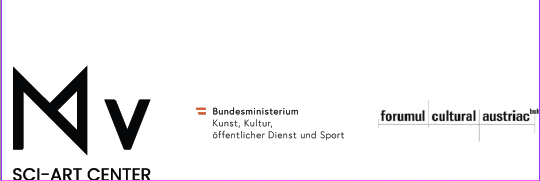

MV sci-art stellt einen Paradigmenwechsel in der Kulturszene Timisoaras dar. Es wurde von der angesehenen Organisation META Spațiu in Zusammenarbeit mit der Polytechnischen Universität in Timișoara ins Leben gerufen und zeugt von deren Engagement für die Förderung der Kreativität an der Schnittstelle zwischen Kunst und Wissenschaft.
MV sci-art ist ein innovativer Ort in der Kulturlandschaft Timisoaras und bietet einen dynamischen Raum, in dem Kunst und Wissenschaft nahtlos ineinander übergehen. Als Gastgeber der Mobilität spielt das Kulturzentrum eine entscheidende Rolle bei der Erleichterung von Recherchen und Interviews für mich und trägt zu einem tieferen Verständnis der sich entwickelnden Kulturszene der Stadt bei.
Mit seiner einzigartigen Betonung des wissenschaftlichen Aspekts der Kunst hebt sich MV sci-art als Drehscheibe für Künstler, Forscher und Enthusiasten hervor, die die Konvergenz dieser beiden Disziplinen erkunden wollen. Mit dieser wissenschaftlichen Ausrichtung unterscheidet es sich von traditionellen Kunsträumen. MV sci-art beschäftigt sich aktiv mit Cross-Over-Projekten, die konventionelle Grenzen überschreiten. Durch die Verflechtung von Wissenschaft, Technologie und neuen Medien ist das Zentrum ein Katalysator für eine neue kreative Welle, die den Zeitgeist trifft. Diese Projekte zeigen nicht nur Innovationen, sondern schaffen auch Möglichkeiten für internationale Verbindungen.
ABOUT MV-sci ART
MV sci-art represents a paradigm shift in the cultural scene of Timisoara. Launched by the prestigious organisation META Spațiu in collaboration with the Polytechnic University of Timișoara, it demonstrates their commitment to fostering creativity at the intersection of art and science.
MV sci-art is an innovative place in Timisoara’s cultural landscape and offers a dynamic space where art and science merge seamlessly. As a host of mobility, the cultural centre plays a crucial role in facilitating research and interviews for me and contributes to a deeper understanding of the city’s evolving cultural scene.
With its unique emphasis on the scientific aspect of art, MV sci-art stands out as a hub for artists, researchers and enthusiasts who want to explore the convergence of these two disciplines. This scientific focus sets it apart from traditional art spaces. MV sci-art actively engages in cross-over projects that transcend conventional boundaries. By interweaving science, technology and new media, the centre is a catalyst for a new creative wave that captures the zeitgeist. These projects not only showcase innovation, but also create opportunities for international connections.
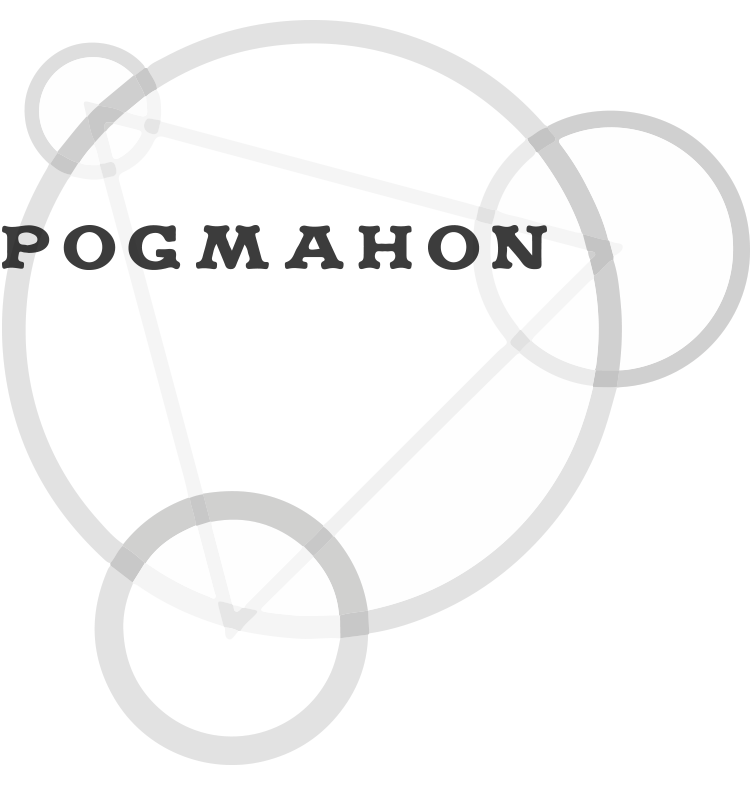
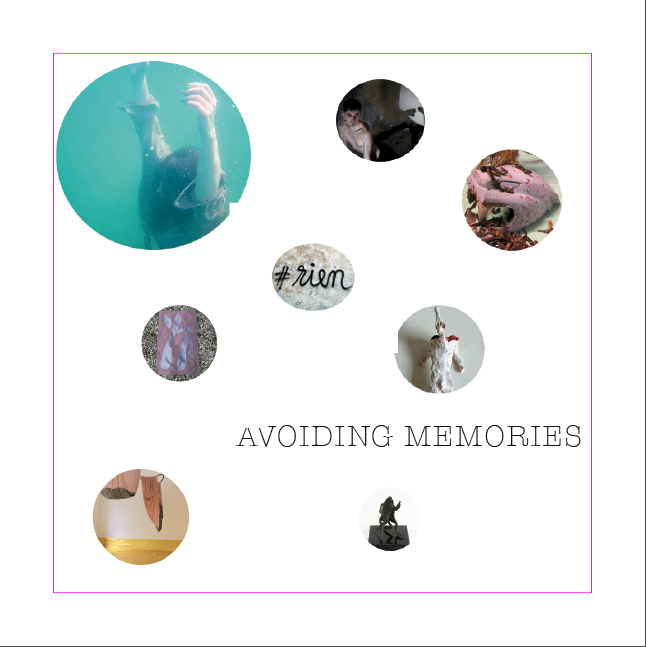
 GUADALUPE ALDRETE
GUADALUPE ALDRETE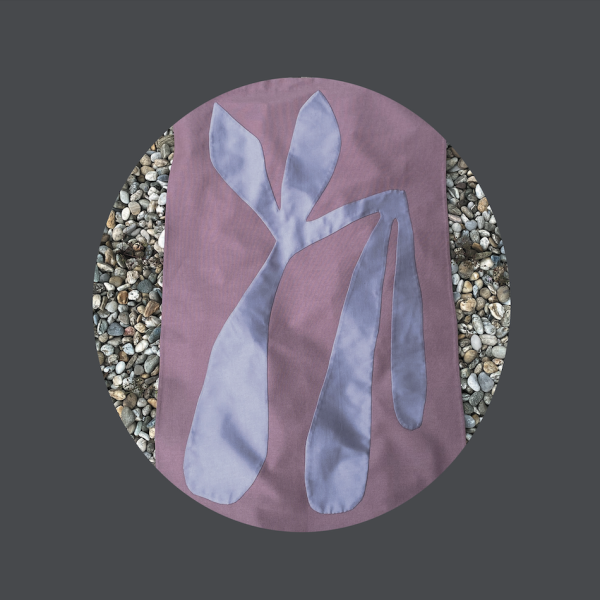 MILA BALZHIEVA
MILA BALZHIEVA PAULA FLORES
PAULA FLORES NATALIA GUROVA
NATALIA GUROVA HUBERT HASLER
HUBERT HASLER ISIDORA KRSTIC
ISIDORA KRSTIC GABRIEL VIRGILIO LUCIANI
GABRIEL VIRGILIO LUCIANI MIHAI ZGONDOIU
MIHAI ZGONDOIU